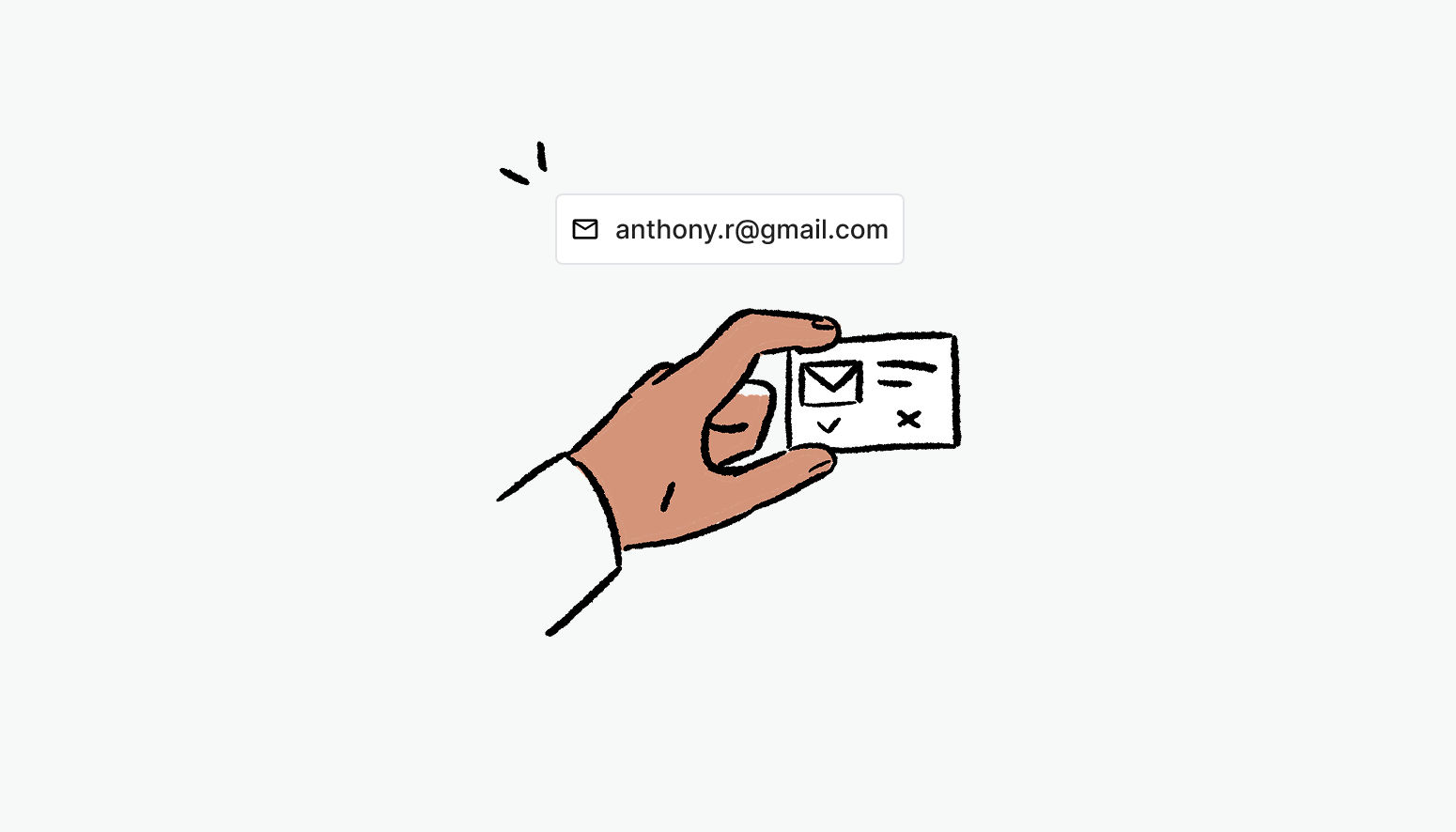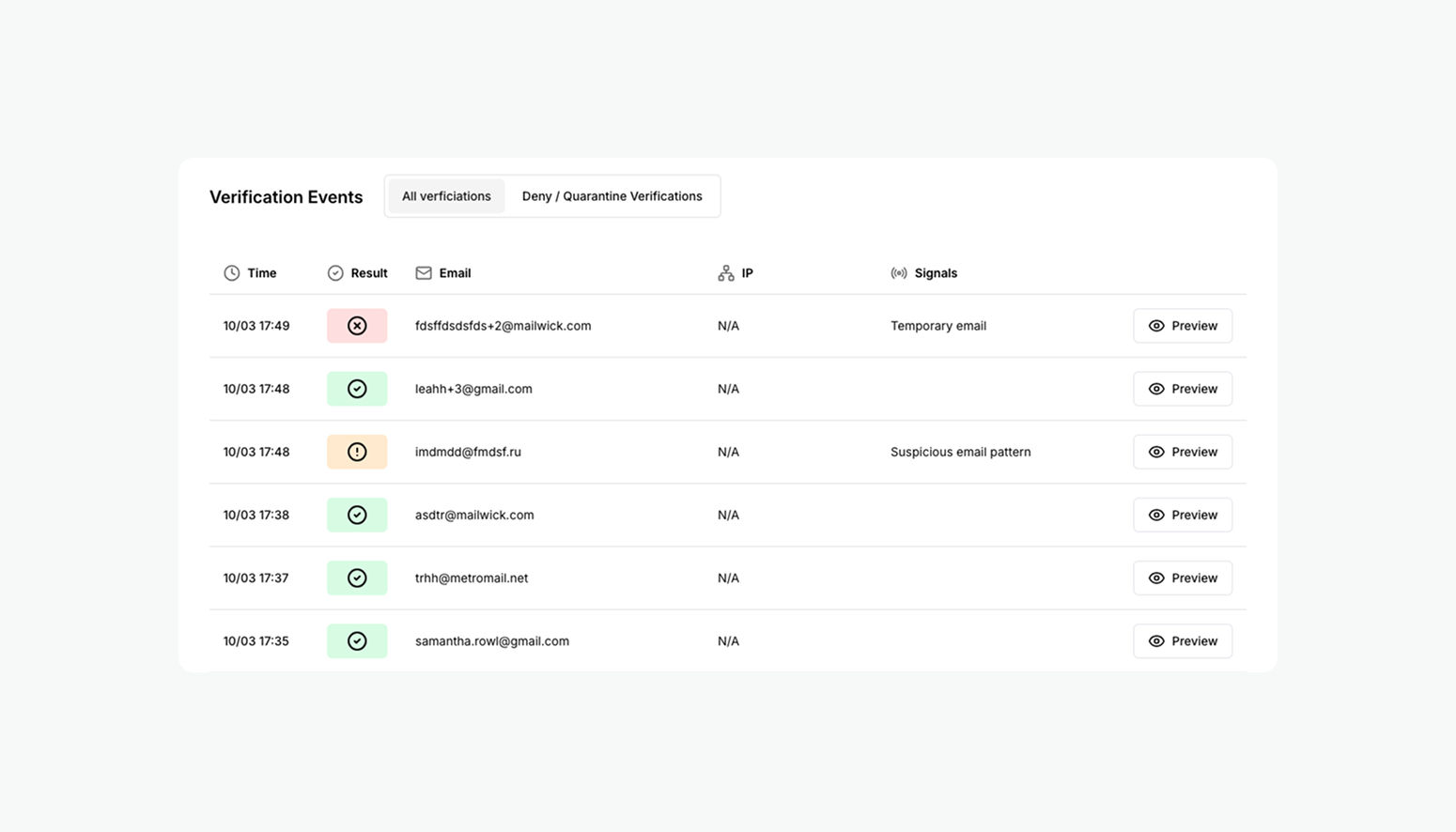
Guide: How to prevent free-tier abuse
Key Takeaways
- Free tier abuse is when users take advantage of the free products and services that SaaS companies provide.
- Abusing the free tier dramatically raises operational costs and eats into company's budget.
- Abusers frequently use temporary emails and VPNs to mask their identities and use automated bots to consume as many free resources as possible.
- Our first prevention step is an easy one - always validating a user provided information. That means building strong email and phone verification flows, analyzing IPs for abnormal activity patterns, and deploying more sophisticated tools such as device fingerprinting.
- Finding the right balance between security measures and overall user experience will be key.
Free-tier abuse happens when users exploit free service plans without genuine intent, often leading to increased costs and reduced resources for legitimate users. This abuse ranges from fraudulent signups and bot-driven activity to simply password sharing.
What is Free Tier Abuse?
Free tier abuse is the exploitation of free services offered by SaaS (software as a service) platforms. These free tiers are designed to onboard and convert new users by providing a taste of the premium features under some limitations. Some bad actors take advantage of these offerings, creating a significant stress on the service providers.
This abuse typically occurs through the exploitation of loopholes or by circumventing limitations, forcing companies to face dire operational and fiscal consequences.
Common SaaS Abuse Scenarios
Frequently, free tier abuse occurs via account farming. This may seem a minor nuisance until bad actors are able to create thousands of fake accounts in one day, costing businesses millions a lot of money.
As an example, Savvy abusers might use temporary emails and VPNs to hide their identity, so they are more difficult to catch in whatever harmful action they are taking. These activities undermine the integrity of the platform.
They further harm the experience of legitimate users by overloading resources and increasing response time.
Impact of Abuse on Your Business
The bottom line is that the financial impact of free tier abuse can be catastrophic. In addition, businesses must cover the higher operational costs associated with hosting and maintaining fake accounts at scale, or dealing with fraudulent activity.
To give you an idea, one of these SaaS owners is losing tens of thousands dollars per month on average from these predatory activities. Beyond spending like a thief on stolen credit cards, revenue loss happens when these abusers skip upgrades or drive away legitimate users with poor service quality.
This abuse directly kills the user experience for legitimate customers. Limited resources, slower speeds, and compromised security can infuriate them, causing them to churn.
With time, these challenges negatively impact your brand reputation and chip away at trust, making it increasingly difficult to keep repeat customers. Some companies, like Oddsjam, have turned abusers into paying customers by implementing safeguards and nudging them toward legitimate use, showcasing potential recovery strategies.

How to Prevent Free Tier Abuse
Preventing free tier abuse is best accomplished with a careful, multi-layered approach that places a premium on technology, monitoring, and clear communication with users about acceptable use. With a few proactive measures, SaaS providers can safeguard their platforms from abuse while preserving the user experience.
Here are more specific tactics to make that a reality.
1. Validate User Contact Information
Forcing users to provide real contact information is a good starting point. Require validation processes like email and phone number verification to ensure users are real.
Approaches such as requiring confirmation codes or relying on third-party validation services are viable solutions. Implement and rigorously monitor. Evaluate all measures taken to ensure they are working.
2. Implement Robust Email Verification
One of the simplest and most effective measures to combat free-tier abuse is to verify email addresses. Numerous open-source lists of temporary domains can be found on GitHub such as FakeFilter.
However, it's important to remember that just verifying temporary domains isn't sufficient. There are also many services that provide temporary Gmail and Hotmail addresses.
Additionally, tools like Apple's Hide My Email can create random email addresses for users, adding another layer of complexity.
3. Verify Phone Numbers
Verifying phone numbers through SMS-based methods is a powerful strategy to minimize free-tier abuse.
By mandating users to confirm their accounts with a phone number, it becomes significantly harder to misuse the service. Unlike temporary email addresses, there is not an unlimited supply of disposable phone numbers.
4. Analyze IP Addresses and Geolocation
Monitoring the use of IP addresses can reveal suspicious activity like the creation of several accounts from one IP address. Geolocation checks can catch high-risk geographic areas, and blocking known proxy or VPN IPs are simple ways to stay safer.
Legitimate versus suspicious IP behavior, like a single IP creating multiple accounts very quickly, assists in training and improving detection systems.
5. Employ Device and Network Fingerprinting
Device and network fingerprinting is very effective way of combating abuse as they are harder to fake for regular day to day users.
This technology makes it challenging for those trying to abuse free-tier services, as it becomes difficult to impersonate regular users.
By analyzing various factors like browser settings, operating system details, network characteristics, service providers, and more can pinpoint suspicious activity and prevent misuse.
Examining a user's network connection can reveal a wealth of distinctive information that can be valuable.
6. Use CAPTCHAs Strategically
CAPTCHA is designed to protect against automated bot attacks. Alternatives such as image recognition, slider puzzles or invisible CAPTCHAs provide more security without compromising user-friendliness.
Regular reevaluation of your CAPTCHA maintains the right type is the most effective, while not hindering user experience. For instance, invisible CAPTCHAs are simply less intrusive, but just as effective in protecting against sophisticated bots.
7. Limit Free Tier Features and Usage
Limiting premium-level features in the free tier reduces the potential for abuse. Usage metrics such as API requests or active hours are critical use case indicators for abuse detection.
By implementing feature throttling or usage limits, users are pressured to upgrade. Transparent, easily understandable communication regarding these limitations goes a long way in instilling trust and preventing future misunderstandings.
8. Require Payment Information Upfront
Collecting credit card information upfront - even if you don’t charge anything on those cards - eliminates the vast majority of fraudulent signups. Payment gateways such as Stripe make this an intuitive, easy process.
Testing the effect on signup conversion rates helps make sure that this step doesn’t scare off legitimate users. Providing sufficient alternatives, including refundable deposits, increases user confidence even more.
9. Monitor User Behavior for Suspicious Activity
Behavior analytics monitor user activity or behavior to identify deviations from the norm. Actions such as rapid account switching and/or high resource utilization may set off alarms.
Frequent data analysis along with public user reporting improves monitoring efficiency. For example, an unexpected increase in the number of API calls made by a free-tier account could be a sign of abuse.

Advanced Abuse Prevention Strategies
Advanced abuse prevention strategies focus on practical measures that all platforms can take to reduce their susceptibility to abuse.
These strategies depend both on technological solutions and industry best practices.
Leverage Machine Learning for Fraud Detection
Machine learning holds incredible promise in detecting abusive signups. By utilizing algorithms that model typical user behavior, you can identify anomalies that could indicate free trial abuse. For instance, a sudden influx of account registrations or suspicious authentication attempts might signal that your free accounts are being exploited.
By developing models specifically designed for finding anomalies, platforms can quickly prevent fraud. Updating these models regularly with new data continues to increase accuracy over time, adjusting to evolving abuse tactics.
By monitoring machine learning solutions in real-time, you can quickly detect and respond to an issue before it becomes a significant threat.
Implement Risk Scoring Systems
Risk scoring systems can be an effective method of determining a user’s level of trustworthiness. These systems calculate risk based on how an account is created, the consistency of log-in IP addresses, payment information and more.
For example, if a user creates an account using a burn email, they may receive a higher risk score. Tracking these scores through time, according to learned tendencies, enables agile abuse prevention.
Ultimately, by adjusting thresholds, you can find the right balance between providing users access without putting your platform at risk.
Conclusion
Free-tier abuse is more than just a nuisance - it can severely disrupt your business operations and compromise the experience for genuine users.
By adopting a multi-layered approach that combines rigorous verification methods, smart usage monitoring, and advanced fraud detection techniques, SaaS companies can significantly mitigate the risks associated with abuse. These measures not only protect your bottom line but also ensure that your platform remains welcoming and accessible to the users who truly add value.
Ultimately, striking the right balance between security and usability is the key to fostering a sustainable ecosystem that benefits both your business and its loyal customers.
Frequently Asked Questions
Free-tier abuse occurs when users exploit free trial promotions to create multiple accounts or utilize disposable email addresses, circumventing intended usage limits without paying. This behavior negatively affects service providers and legitimate users, highlighting the need for an effective abuse management system to prevent abuse.


